
The gray whale, also known as the grey whale, is a baleen whale that migrates between feeding and breeding grounds yearly. It reaches a length of 14.9 meters (49 ft), a weight of up to 41 tonnes (90,000 lb) and lives between 55 and 70 years, although one female was estimated to be 75–80 years of age. The common name of the whale comes from the gray patches and white mottling on its dark skin. Gray whales were once called devil fish because of their fighting behavior when hunted. The gray whale is the sole living species in the genus Eschrichtius. It is the sole living genus in the family Eschrichtiidae, however some recent studies classify it as a member of the family Balaenopteridae. This mammal is descended from filter-feeding whales that appeared during the Neogene.

Entomology is the scientific study of insects, a branch of zoology. In the past the term insect was less specific, and historically the definition of entomology would also include the study of animals in other arthropod groups, such as arachnids, myriapods, and crustaceans. This wider meaning may still be encountered in informal use.

Atracidae is a family of mygalomorph spiders, commonly known as Australian funnel-web spiders or atracids. It has been included as a subfamily of the Hexathelidae, but is now recognised as a separate family. All members of the family are native to Australia. Atracidae consists of three genera: Atrax, Hadronyche, and Illawarra, comprising 35 species. Some members of the family produce venom that is dangerous to humans, and bites by spiders of six of the species have caused severe injuries to victims. The bites of the Sydney funnel-web spider and northern tree-dwelling funnel-web spider are potentially deadly, but no fatalities have occurred since the introduction of modern first-aid techniques and antivenom.

John Obadiah Westwood was an English entomologist and archaeologist also noted for his artistic talents. He published several illustrated works on insects and antiquities. He was among the first entomologists with an academic position at Oxford University. He was a natural theologian, staunchly anti-Darwinian, and sometimes adopted a quinarian viewpoint. Although he never travelled widely, he described species from around the world on the basis of specimens, especially of the larger, curious, and colourful species, obtained by naturalists and collectors in England.

Francis Walker was an English entomologist. He was born in Southgate, London, on 31 July 1809 and died at Wanstead, England on 5 October 1874. He was one of the most prolific authors in entomology, and stirred controversy during his later life as his publications resulted in a huge number of junior synonyms. However, his assiduous work on the collections of the British Museum had great significance.
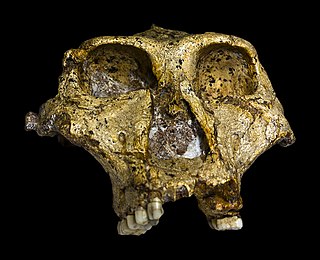
Paranthropus robustus is a species of robust australopithecine from the Early and possibly Middle Pleistocene of the Cradle of Humankind, South Africa, about 2.27 to 0.87 million years ago. It has been identified in Kromdraai, Swartkrans, Sterkfontein, Gondolin, Cooper's, and Drimolen Caves. Discovered in 1938, it was among the first early hominins described, and became the type species for the genus Paranthropus. However, it has been argued by some that Paranthropus is an invalid grouping and synonymous with Australopithecus, so the species is also often classified as Australopithecus robustus.

Bothriospondylus is a dubious genus of neosauropod sauropod dinosaur. It lived during the Late Jurassic in England, and the type and only species is B. suffossus.

David Sharp was an English physician and entomologist who worked mainly on Coleoptera. He was among the most prolific publishers in the history of entomology with more than 250 papers that included seven major revisions and reviews and a highly influential work on the structure and modifications of the male genital structures among the beetle families. He was the editor of the Zoological Record for three decades.
The British Entomological and Natural History Society or BENHS is a British entomological society. It is based at Dinton Pastures Country Park in Reading, England.

Carnidae, also known as bird flies or filth flies, is a family of flies (Diptera). There are 6 genera, containing about 93 species worldwide.

Phalacrognathus muelleri, colloquially known as the rainbow stag beetle, and also the king, magnificent or Mueller's stag beetle, is a species of beetle in the family Lucanidae. It is found in northern Queensland, Australia and New Guinea. It can come in red, green, black, and blue forms. It is the only species in its genus, Phalacrognathus, which is closely related to the genus Lamprima.

John Henry Leech was an English entomologist who specialised in Lepidoptera and Coleoptera.

Athericidae is a small family of flies known as water snipe flies or ibis flies. They used to be placed in the family Rhagionidae, but were removed by Stuckenberg in 1973. They are now known to be more closely related to Tabanidae. Species of Athericidae are found worldwide.
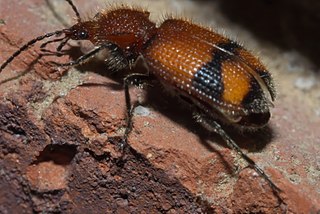
Panagaeus is a genus in the beetle family Carabidae, native to the Holarctic, the Near East, and North Africa, as well as Central and South America. There are about 15 described species in Panagaeus.
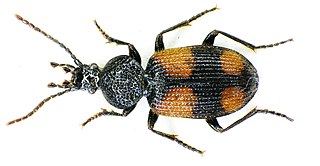
Panagaeus bipustulatus is a species of ground beetle native to Europe and the Near East. In Europe, it is found in Austria, Belarus, Belgium, Bosnia and Herzegovina, Bulgaria, the Czech Republic, mainland Denmark, Estonia, Finland, mainland France, Germany, Great Britain including the Isle of Man, Hungary, mainland Italy, Kaliningrad, Latvia, Liechtenstein, Lithuania, Luxembourg, Moldova, Poland, Romania, Russia, Slovakia, Slovenia, mainland Spain, Sweden, Switzerland, the Netherlands and Ukraine.
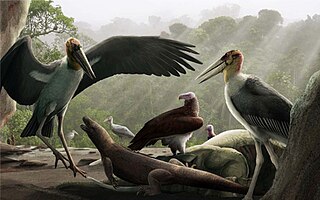
Leptoptilos robustus is an extinct species of large-bodied stork belonging to the genus Leptoptilos that lived on the island of Flores in Indonesia during the Pleistocene epoch. It stood at about 1.8 metres (5.9 ft) tall and weighed up to an estimated 16 kilograms (35 lb). The majority of the discoveries are concentrated in Liang Bua cave located slightly north of Ruteng in the East Nusa Tenggara province.

Parastylotermes is an extinct genus of termite in the Isoptera family Stylotermitidae known from North America, Europe, and India. The genus contains five described species, Parastylotermes calico, Parastylotermes frazieri, Parastylotermes krishnai, Parastylotermes robustus, and Parastylotermes washingtonensis.
Phrynotettix robustus, known generally as the robust toad lubber or robust toad hopper, is a species of lubber grasshopper in the family Romaleidae. It is found in North America.
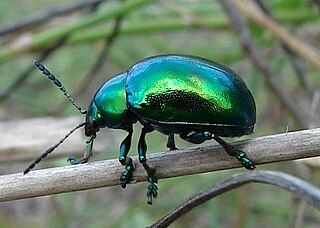
Eumolpus robustus is a species of leaf beetle from North America. It has the most northern range of the members of the genus Eumolpus, spanning from Central America north to Mexico and Arizona.

The genus Microrestes combines relatively small and squat Phasmatodea species from continental Southeast Asia and South China.
















